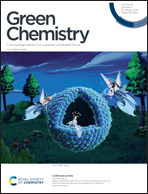Direct synthesis of a high-density aviation fuel using a polycarbonate†
Abstract
High-density cyclic hydrocarbons were first synthesized with high carbon yields by a one-pot transfer hydrodeoxygenation of a polycarbonate (PC) using isopropanol as the solvent and hydrogen donor at the same time. RANEY® nickel was found to be an effective catalyst for the conversion of the PC in isopropanol. Over it, the pure PC pellet was completely converted to a mixture of C6–C15 oxygenates, aromatics and cycloalkanes after the reaction was carried out at 463 K for 1 h. The catalytic performance of RANEY® Ni was further improved after the introduction of solid acids as co-catalysts. Among the investigated solid acids, ultrastable Y (USY), a commercial acidic zeolite, demonstrated the best promotion effect, which can be explained by its larger pore size and suitable acidity. Under the optimized conditions, an ∼75% carbon yield of C6–C15 cyclic hydrocarbons was achieved from the one-pot transfer hydrodeoxygenation of a chopped DVD disk under the co-catalysis of RANEY® Ni and USY. According to our measurement, the C6–C15 cyclic hydrocarbon mixture as obtained has a high density (0.94 g mL−1), good volumetric net heat of combustion (NHOC) (41.5 MJ L−1) and low freezing point (202 K–188 K). In real applications, it can be used as a potential substitute for currently used high-density aviation fuels.



 Please wait while we load your content...
Please wait while we load your content...